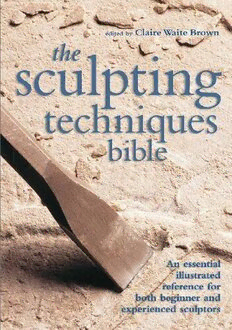
The Sculpting Techniques Bible: An Essential Illustrated Reference for Both Beginner and Experienced Sculptors PDF
Preview The Sculpting Techniques Bible: An Essential Illustrated Reference for Both Beginner and Experienced Sculptors
The Sculpting Techniques Bible The Sculpting Techniques Bible An essential illustrated reference for both beginner and experienced sculptors Edited by Claire Waite Brown Contents Introduction 6 Firing 69 Moldmaking 72 Getting started 8 Casting 79 Studio guidelines 10 Direct modeling 88 Clay 12 Carving 94 Plaster 20 Relief 104 Cement and Construction 116 cement fondue 24 Assemblage 124 Polyester resin 26 Surface finishes 126 Stone 28 Bases 140 Wood 33 Construction equipment 38 Themes 144 Making armatures 40 People 146 Making bases 41 Animals 154 Finishing materials 42 Nature 159 Objects 164 Techniques 46 Composition 171 Preliminary planning 48 Surface texture 175 Solid modeling 50 Relief 180 Hollow modeling 54 Surface modeling 58 Glossary 184 Armatures 61 Suppliers 187 Modeling clay on an Index 188 armature 65 Credits 192 6 Introduction Making sculpture—the art of manipulating material to create three-dimensional form—is an extremely pleasurable,intense,and rewarding experience.It is an activity that is intrinsic to human nature,dating from prehistoric times when stone was first carved. Carving and modeling are the traditional techniques used in sculpture.However,with the evolution of new materials and techniques,the range of possibilities available to the sculptor has greatly expanded. The techniques described in this book will provide the novice or practicing sculptor with a solid foundation on which to build a repertoire of sculpting skills.It illustrates the fundamental Build a techniques of sculpting and shows you how to use basic collection of materials.If you have never made a sculpture before,you will tools undoubtedly find in the following pages a technique you can use to start you off,while more experienced sculptors will discover the possibilities that lie with untried techniques or materials. The book begins with a section aimed at arming you with all the information you need to get started.The various sculpting materials,and the tools needed to work them,are discussed here,along with relevant safety information and any necessary preparatory techniques.The techniques section then covers the practical aspects of sculpting,including modeling with clay Discover the characteristic properties of materials 7 and plaster,making molds and casts from various materials,and carving and construction techniques.There are also examples of finishes you can apply to the surface of your sculpture,and a look at suitable bases you may choose to show your work off to its full potential. The final section is designed to help you learn by example,and features the work of many and varied sculptors.While the best thing about being a sculptor is enjoying what you do and experimenting with your own style, Learn from the work of looking at how other artists work can help you to professional artists discover your own interests. Developing skills is important,but what matters even more is that you take pleasure in what you do,so treat this book as a springboard to launch you into the exciting world of sculpture. Discover how to handle tools with confidence Chapter One GETTING STARTED 10 Getting started Studio guidelines Having a designated studio space will make your sculpting experience all the more enjoyable,and allows you to close the door on your work if it ever gets frustrating.A garage,attic,basement,spare room in the house,or disused warehouse can all be equipped to provide just such a space.The basic necessities are good lighting,storage space for tools,materials,and finished work,plenty of work surface space,and access to running water for mixing materials and cleaning up. It is important that you keep the studio as tidy as possible.Tools and equipment stored neatly on shelves or in a cupboard are more likely to stay in prime condition and can be quickly found when needed.It is also vital that different types of material are kept apart—for example,clay should be kept well away from chips of stone,and plaster,which needs to be kept dry,must be stored away from clay,which has to remain damp. Studio layout 1 Important factors in working out the design for a studio are good 4 light (1), both natural and artificial, and ventilation 8 (2), as much work surface as possible (3), secure 7 storage facilities (4), and clear floor space (5). It is also vital to have a sink and running water close at hand (6), large 2 3 garbage cans (7), a fire extinguisher (8), and 9 plenty of electric wall 6 sockets (9). 5
